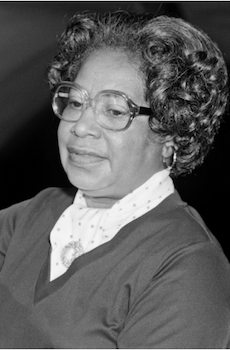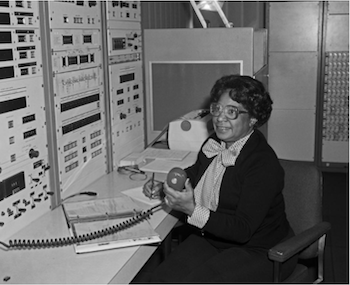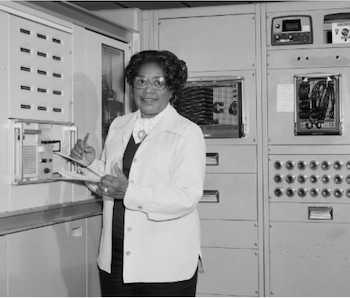
Born on April 9, 1921, in Hampton, Virginia, Mary Winston Jackson was the youngest of Ella and Frank Jackson’s 10 children.
Jackson graduated from George P. Phenix High School with the highest honors in 1938. Then, she attended Hampton Institute, a historically black university. At the university, she pledged to the Gamma Theta chapter of the Alpha Kappa Alpha sorority, the first black female sorority. In 1942, she earned her mathematics and physical science degrees. After spending a year teaching mathematics at a high school in Calvert County, Maryland, Jackson returned to Hampton as a secretary and bookkeeper at the King Street United Service Organization in 1943. There, she would meet her future husband Levi Jackson Sr. whom she married in 1944. At her wedding, Jackson defied traditional wedding customs by wearing a short white dress with black sequins, pumps, gloves, and a red corsage. They had 2 children, Levi Jr. and Carolyn Marie.
Jackson’s diligence, attention to detail, and tendency to go above and beyond led to her employment at Fort Monroe, another United Service Organization. In 1951, she only worked there for 3 months as a mathematician in the West Area Calculus department which consisted of all black women mathematicians working under Dorothy Vaughan.

Vaughan would assign Jackson to many divisions, but she mostly worked in the Supersonic Speed Tunnel in 1953. Specifically, the Supersonic Speed Tunnel was used to measure the force of the winds at twice the speed of sound on airplanes. Kazimierz Czarnecki, the head engineer, recognized Jackson’s intelligence and advised her to pursue engineering. Due to continued segregation in Virginia, she had to go to court to be allowed to take night classes. Her appeal was granted and she eventually received her qualifications to become the first Black woman engineer in 1958.
Jackson ascended to the highest level of engineering in her career, working in 5 departments, including the Compressibility Research Division. She was also the author and co-author of 12 technical papers.
In the early 1970s, National Aeronautics and Space Administration’s (NASA) directors met up to create more intentional inclusion in the organization. Jackson received a demotion as an engineer in Virginia, and she moved to Washington, D.C. to train and become an equal opportunity specialist at NASA. Yet, Jackson returned to Langley, Virginia where she trained women and other minorities to get promoted in NASA with the necessary qualifications. She headed two programs: Affirmative Action Program and the Federal Women’s Program. These programs at NASA were inspired by her own experiences; she could not get promoted any further than a supervisor. Running these programs alone was considered a demotion in her workplace status.

Apart from her career at NASA, Jackson also led Bethel AME’s Girl Scout Troop No. 11, an all-black group for 30 years. She ensured their preparation to “take their place in the world”. With her creativity, Jackson went beyond the Girl Scout manual to greater expose her troops to the world and elevate their lives. For example, she provided job shadowing opportunities, afternoon tea, and singing songs that were not about negative stereotypes in the Black Community. Furthermore, Jackson would take part in many engineering-related community activities such as “The Aspects of Engineering for Women'' in 1962, where Jackson and other women on the panel spoke about their career journeys. Jackson also helped the children build a wind tunnel in the 1970s.
Jackson passed away at the age of 83 in Hampton, Virginia, nearly 20 years after her husband died in 1992. Jackson is survived by her children: Levi Jr. and Carolyn Marie. Jackson also had three grandchildren and three great-grandchildren.
Her life and work have been memorialized in the non-fiction book Hidden Figures and the movie based on the book in 2016. She has a high school in Salt Lake City, Utah, and the NASA building in Washington, D.C. named after her in 2018 and 2021, respectively. On November 6, 2020, a launched satellite was named after her.
Mary Winston Jackson excelled both in her career and personal life despite the odds against her. She not only opened the doors to excel as a black woman at NASA but also to keep those opportunities open for the future of talented minds of overlooked individuals.
Why Did I Choose to Research Mary Winston Jackson?
Mary Jackson faced systemic racism but pursued her dreams anyway. She not only opened the doors to becoming a black woman engineer but kept them open through her work at NASA and in her local community. She is a reminder that you need to keep finding all the ways to get to what you want before you completely give up. I have also been fascinated by the space race and exploring what’s beyond our planet.
Works Cited
Biography.com. Mary Jackson Biography (January 12, 2021). Retrieved From https://www.biography.com/scientists/mary-winston-jackson
Britannica.com. Mary Jackson Mathematician and Engineer (April 5, 2024). Retrieved From https://www.britannica.com/biography/Mary-Jackson-mathematician-and-engineer
Jones, Shelly M. (2019) Women Who Count: Honoring African American Women Mathematicians. p. 60-61 Retrieved From https://books.google.co.za/books?hl=en&lr=&id=-z2mDwAAQBAJ&oi=fnd&pg=PP1&dq=mary+jackson+nasa&ots=N_t0aTZ_Hs&sig=PMCYN5pkn2xSTkbg23oEzQMZJb4&redir_esc=y#v=onepage&q=mary%20jackson%20nasa&f=false
Legacy.com. Mary Jackson Obituary (February 13 to 16, 2005). Retrieved From https://www.legacy.com/us/obituaries/dailypress/name/mary-jackson-obituary?id=29565028
Slideshare.net. Mary Jackson Slide Presentation (February 23, 2017). Retrieved From https://www.slideshare.net/montebil/mary-jackson
Shetterly, Margot L. (2016). Hidden Figures. Harper Collins Publishers
This article was published on 6/17/24